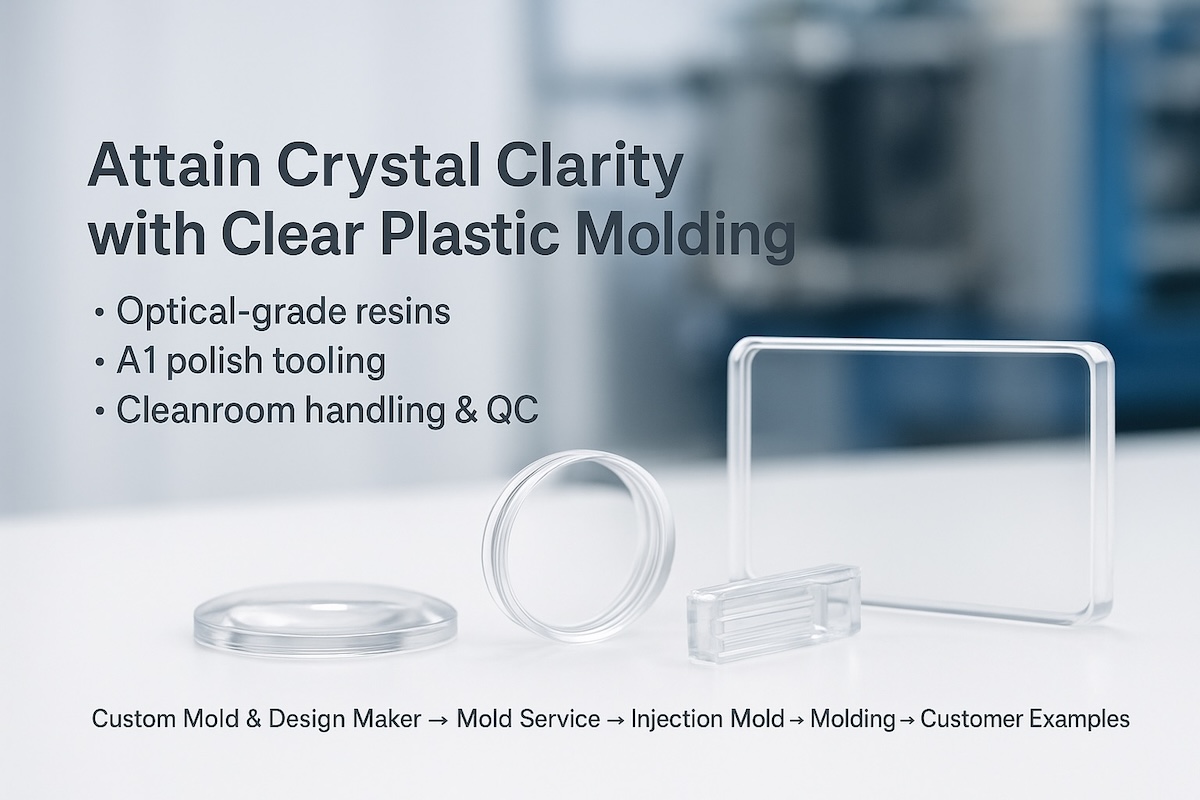Attain Crystal Clarity Using Clear Plastic Molding for Display and Optical Components
Attain Crystal Clarity Using Clear Plastic Molding for Display and Optical Components

Attain Crystal Clarity Using Clear Plastic Molding for Display and Optical Components
Optical-grade resin selection • A1 polish tooling • Cleanroom handling & QC
If your product lives or dies by what users see, clarity isn’t a “nice to have”—it’s the spec. This guide shows how the TaiwanMoldMaker.com network engineers display covers, lenses, light-pipes, windows, and microfluidic parts that are crystal clear, durable, and repeatable from pilot to mass production.
Explore our end-to-end services:
Custom Mold & Design Maker → Mold Service → Injection Mold → Molding → Customer Examples → Contact
What “optical-grade” really means
-
Resin purity & drying: Low volatiles/contaminants; moisture tightly controlled to prevent splay and bubbles.
-
Surface quality: Tooling to SPI A1 mirror polish or better; optical inserts isolated and protected.
-
Stress control: Gate, pack/hold, and cooling tuned to minimize birefringence and knit-line visibility.
-
Particle control: Cleanroom molding/assembly with ionized air, HEPA capture, and glove protocols.
-
Measurement: Haze %, total light transmission, optical distortion/wavefront, ΔE/gloss where relevant.
Fast material chooser (clear & transparent grades)
| Goal | Best Fits | Notes |
|---|---|---|
| Tough, clear display covers | PC (optical grades) | Great impact; manage stress & chemical exposure. |
| Highest clarity, easy polish | PMMA (acrylic) | Gorgeous optics; lower impact than PC. |
| Low autofluorescence / microfluidics | COC / COP | Excellent chemical & optical stability. |
| Chemical resistance + clarity | PETG, Tritan™ (copolyester) | Good cosmetics; watch heat deflection. |
| High-temp optics / thin walls | PEI (Ultem™) | Amber-clear; process window is tighter. |
| Light-pipes / LEDs | PMMA, PC (light-guide grades) | Specify refractive index & yellowness index. |
We’ll shortlist grades by clarity, UV, impact, regulatory (food/medical), and sterilization needs.
Design for clarity (DFM you can measure)
-
Wall strategy: Keep walls uniform (1.5–3.0 mm); use ribs/fillets to avoid sinks and hotspots.
-
Radii & draft: Generous radii and ≥1–2° draft (more on textured edges) to preserve polish and ejection.
-
Gate placement: Flow from non-viewing edges; use submarine/edge/fan gates or valve gates for vestige-free optics.
-
Knit lines: Eliminate on viewing zones; move to masked regions or break with geometry/light traps.
-
Ejector strategy: Push from bosses or unseen pads; avoid pin marks in optical paths.
-
Light-pipe rules: Polished channels, controlled bend radii, frosted emitters/couplers, and spec’d NR (nickel reflectors) if used.
Tooling & surface engineering (how we get “glasslike”)
-
Steel & finish: S136/420SS optical inserts, hardened and hand-polished to A1; protect during all bench ops.
-
Cooling first: Balanced, turbulent circuits; conformal-cooled inserts where geometry traps heat to cut residual stress.
-
Venting: Micro-vents around last-to-fill; vacuum assist on lenses to avoid burn and flow lines.
-
Hot halves: Valve gating with sequential control for large windows; hot parts selected for optical resins.
-
Maintainability: Dedicated handling fixtures; lint-free covers; serialized inserts with polish history.
Processing window (reference starting points)
-
Drying: PC/PEI/COC typically 120–130 °C (per datasheet); PETG/PMMA lower temps but longer times.
-
Melt & mold temps: Melt as spec’d; warmer molds (70–120 °C) improve gloss and knit-line healing.
-
Fill/pack: Fast but controlled injection to avoid jetting; hold pressure ramps tuned from gate-freeze studies.
-
Purge & housekeeping: Dedicated screws/barrels or validated purge sequences to prevent black specks/gel.
Optical QC & reliability tests
-
Haze/transmittance (per ASTM/ISO), birefringence maps, optical distortion on gauges or interferometry.
-
Cosmetic map sign-off with viewing zones and sampling plan.
-
Abrasion & chemical wipe (Taber, sunscreen/sweat, cleaners); UV aging with ΔE targets.
-
Snap-fit & screw boss fatigue for display covers; leak/occlusion for microfluidics.
Typical applications we build
-
Smartphone/tablet display windows, HMI covers, appliance panels.
-
Lenses & light-pipes for wearables, lighting, and indicators.
-
Microfluidic chips, cuvettes, labware (optically clear with low autofluorescence).
-
Retail showcase parts and premium product shells with paint-free cosmetics.
Example timeline (pilot → ramp)
-
Day 0–2: 48-Hour DFM Pack (flow/cool/warp, gate & knit-line plan, cycle model) → alignment call
-
Day 3–10: Tool build (Al/MUD or pre-hard steel); polish to SPI A1; EOAT/fixture in parallel
-
Day 11–13: T0 in production resin; weight ladder + gate-freeze; haze/gloss screening
-
Day 14–15: T1 + FAIR + CMM/scan; optical metrics (haze/TLT), cosmetic sign-off; ship FA parts
-
Day 16+: Copy-cavity proposal; conformal cooling inserts for scale where ROI is strong
(Steel-first or multi-cavity optics: ~20–28 days to T0 depending on size/finish.)
RFQ checklist (copy/paste—prevents rework)
-
Target T1/SOP dates; must-hit gates (DFM/T0/T1).
-
CAD (STEP/IGES) + 2D with CTQs/GD&T; cosmetic & viewing zone map.
-
Resin options (PC/PMMA/COC/COP/PETG/PEI) and compliance (UV/food/medical).
-
Optical metrics required: haze %, TLT, yellowness index, birefringence/MTF if lens-grade.
-
Tool plan: A1 polish, valve vs edge/fan gate, conformal-cooling candidates.
-
Process & data: DOE scope, cavity pressure, MES access (OEE, CpK, scrap, kWh/kg, genealogy).
-
Coatings/graphics: Hard-coat, AR/AS/AF, IML/IMD, laser mark or print.
-
Packaging & logistics: Film protectors, clean bag, humidity control, FA courier path, Incoterms.
Send your package here → Contact
Why TaiwanMoldMaker.com for “glasslike” plastics
-
Optics-ready tools (A1 polish, venting, valve gating) and cleanroom molding.
-
Simulation-led DFM with conformal cooling and scientific molding to reduce stress and knit lines.
-
Audit-ready documentation and MES visibility so stakeholders approve fast.
Start here:
Injection Mold → Molding → Mold Service → Customer Examples → Contact








